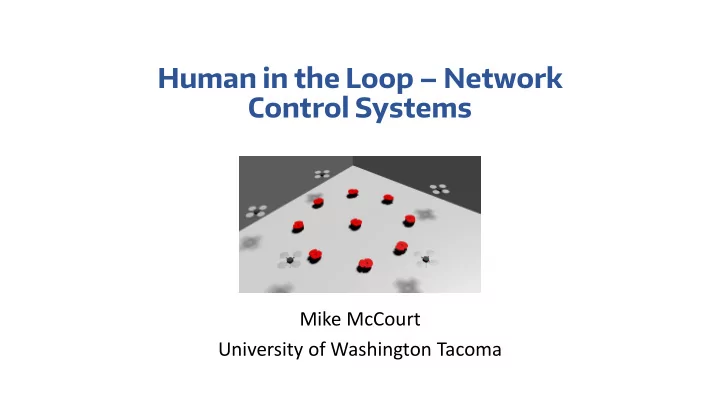

Human in the Loop – Network Control Systems Mike McCourt University of Washington Tacoma
Prio ior research • Nonlinear analysis of hybrid systems • Passivity, dissipativity, conic systems • Hybrid systems: Switched systems, hybrid automata, discrete event systems q 1 q 2 • Network control systems • Delays, dropped packets, quantization • Motivated by… • Cyber-physical-systems • Human-robotic systems • Telemanipulation systems • Human-in-the-loop control
Ongoin ing research proje jects • Human control implemented over networks • Human-machine joint control • Human-machine sensor fusion for estimation • Adaptive randomized path planning • Nonlinear/non-Gaussian estimation problems • Estimation of team behavior • Estimating human intent from EKG data
Estim imation and control problems • Estimation of team behavior • Teams can be autonomous agents, humans, or both • Information could be available or limited • Monitoring continuous states (position, velocity, etc.) as well as discrete behaviors (sensing, acting, group actions) • Human control over networks • Human as a non-ideal controller • Potentially unstable plant • Network effects (delays, lost data, etc.)
Motivation for team estim imation • Monitor a team with limited information • Could be self-reported information or observed • Make decisions based on agent states and behaviors • Better information fusion leads to better decision making • Interested in tracking… • Continuous states: position, velocity, etc. • Discrete states: sensing, moving towards goal, interacting with the environment • Applications • Network intrusion detection • Robotic soccer strategy • Economic strategy models
Hyb ybrid id system estim imation approach • Estimation performed in stages • Continuous states then discrete variables • Discrete estimator can be broken into two parts • Individual agent actions considered before collective team behaviors • Under certain conditions can use discrete estimator to update the continuous estimator
Appli lication: Robotic vehic icle le formation id identification • We applied this approach to estimating an opposing teams formation • Ring, line, random motion • Incomplete information • Can only sense a subset of the opponent agents (40-60%) • Measurements have Gaussian additive noise • Applied EKF for continuous state estimation
Dis iscrete state estim imation • Developed geometric rules for determining formation • Score based on closeness to ring/line shape • Collected data on randomly generated formations • Fit a Gaussian distribution based on noisy generated data • Naïve approach • Used this score to update discrete state of the team behavior • Hidden Markov model (HMM) • Generate a likelihood of each state • At each step, belief changed using a Bayesian update law
Feedback mechanis ism for updatin ing contin inuous estim imator • Can use knowledge of the discrete state to update the continuous states • When discrete behavior is known with some confidence, can generate virtual measurements
Exp xperimental valid lidation • Three graduate students implemented this as a summer project • Five mobile robots, alternating between three discrete team states • Results were promising but requires additional testing
Human Control Over Networks
Human in in the control lo loop • Assumptions… • Nonlinear (possibly unstable) plant • Control over wireless network (delays, etc.) • Classic nonlinear control approaches… • Passivity • Dissipativity • Small gain theorem • These can’t be directly applied due to… • Network delays • Unstable plant
Exis xisting approaches for human-in in-the-loop • Telemanipulation or networked control • Assumes the human is a passive system • “Network interface” to maintain stability despite network delay • Wave variable transformation • Generalized network interface • Problem: Doesn’t work for human in the loop • Can’t handle delays in the systems [Hirche, et al. 2009] • Typical human reaction time delay is 200-500 ms
Solu lution – two new transforms • Transforms are implemented on each side of the network • These can be used to “pre - stabilize” each side • On the human side, the transform scales down the response • Slows system response • On the plant side, the transform rotates • Based on conic system analysis • Stability results follow using the small gain theorem
Plant transformation… • We are applying an input-output variable transformation • Can be described as a rotation • Can take an unstable conic system and rotate it to be stable
Apply lying this is to human controlled vehic icle le exp xperim iments • Supervising undergraduate research applying this to ground robots • Turtlebot 3 • Wifi for network • The goal is to have a human controlled ground robot using wireless internet as a delayed network
Thank you!
Recommend
More recommend